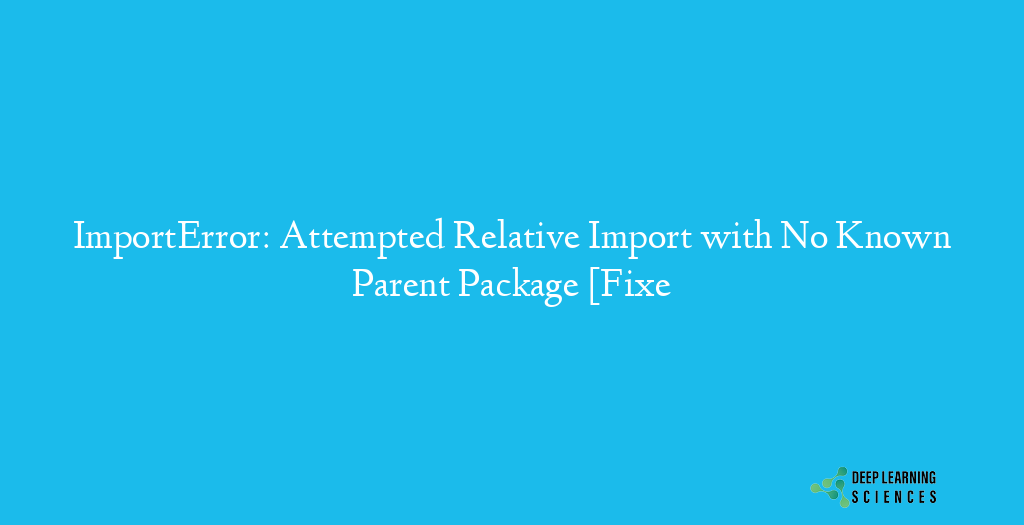“ImportError: Attempted Relative Import with No Known Parent Package” error typically occurs when attempting to import a module or package using a relative path, but the Python interpreter is unable to determine the correct parent package. In this article, we will explore the causes behind this error and provide step-by-step solutions to fix it.

Several factors can lead to the “ImportError: Attempted Relative Import with No Known Parent Package” error. Understanding these causes will help you identify the root of the problem and apply the appropriate solution. Some common causes include:
- Incorrect file structure:
If the file structure of your Python project is not set up correctly, the interpreter may struggle to locate the parent package. - Relative import without a parent package:
When using relative imports, it is crucial to have a known parent package. If the parent package is not specified or is unknown, the import will fail. - Incorrect PYTHONPATH configuration:
The PYTHONPATH environment variable allows the interpreter to search for modules and packages in specified directories. If the PYTHONPATH is not correctly configured, the import resolution process may fail.
How To Fix ImportError: Attempted Relative Import with No Known Parent Package in Python?
To fix the “ImportError: Attempted Relative Import with No Known Parent Package” error, you can follow these steps:
1. Check the File Structure
Ensure that your Python project’s file structure adheres to the recommended standards. Organize your modules and packages properly, with a clear hierarchy.
2. Use Absolute Imports
Instead of relying on relative imports, switch to using absolute imports. Absolute imports specify the full path from the root package to the desired module or package. This approach eliminates the ambiguity of relative imports.
3. Add an Empty init.py File
If you’re working with a package, ensure that each directory in the package contains an empty file named “init.py”. This file is required to mark the directory as a Python package.
4. Modify the PYTHONPATH Variable
Check your PYTHONPATH configuration and ensure that it includes the necessary directories where your modules and packages are located. Adjust the PYTHONPATH variable to add the appropriate paths.
5. Use Virtual Environments
Create and activate a virtual environment for your Python project. Virtual environments provide isolated environments with their own dependencies, reducing the chances of conflicting imports.
6. Update Python and Dependencies
Ensure that you are using the latest version of Python and any relevant dependencies. Outdated versions may have compatibility issues that can lead to import errors. Upgrade Python and the associated libraries to their latest versions.
Also Read: Fix AttributeError: ‘numpy.ndarray’ object has no attribute ‘append’ [Easily]
Testing the Solution
After implementing the suggested solutions, it’s essential to test your code to verify whether the “ImportError: Attempted Relative Import with No Known Parent Package” error has been resolved. Execute your program or run your tests to ensure that the imports are working correctly and the error no longer occurs.
Here’s an example that demonstrates an error in the code and how you can fix it to resolve the “ImportError: Attempted Relative Import with No Known Parent Package” error:
# File structure:
# my_project/
# ├── main_package/
# │ ├── __init__.py
# │ └── module_a.py
# └── test.py
# test.py
from .main_package.module_a import some_function # Error: Attempted relative import
def main():
some_function()
if __name__ == "__main__":
main()
In the above example, the initial code attempts to perform a relative import by using the dot notation (from .main_package.module_a import some_function). However, this results in the “ImportError: Attempted Relative Import with No Known Parent Package” error.
To fix this error, you can modify the import statement to use an absolute import:
# Fixed test.py
from main_package.module_a import some_function # Fixed import statement
def main():
some_function()
if __name__ == "__main__":
main()
By removing the dot notation and using an absolute import (from main_package.module_a import some_function), the error is resolved. The code will now execute successfully without raising the “ImportError” error.
Remember to adjust the import statements according to your specific project structure and module names to ensure a correct and functional solution.
Conclusion
Fixing the “ImportError: Attempted Relative Import with No Known Parent Package” error is crucial for smooth Python development. By understanding the causes behind this error and following the step-by-step solutions provided in this article, you can resolve import errors and ensure the successful execution of your Python projects.
FAQs
Why am I getting the “ImportError: Attempted Relative Import with No Known Parent Package” error?
This error occurs when you try to import a module or package using a relative import statement without providing the necessary context for the interpreter to locate the parent package.
How can I fix the “ImportError: Attempted Relative Import with No Known Parent Package” error?
There are several solutions you can try: checking the file structure, using absolute imports, adding an empty init.py file, modifying the PYTHONPATH variable, using virtual environments, and updating Python and dependencies.
What is the purpose of the init.py file in Python?
The init.py file is required in each directory of a package to mark it as a Python package. It initializes the package and allows it to be imported and used as a module.
Can I use relative imports without a known parent package?
No, relative imports require a known parent package. Without specifying the parent package, the Python interpreter won’t be able to resolve the import correctly.
Why should I use virtual environments when working with Python projects?
Virtual environments provide isolated environments for your Python projects, allowing you to manage dependencies and avoid conflicts between different projects. They ensure that each project has its own set of dependencies and Python interpreter, keeping your development environment clean and organized.